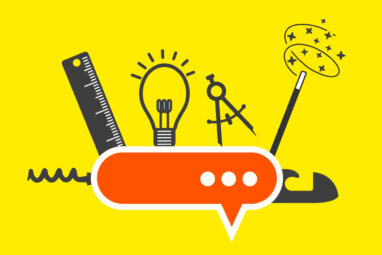How GenAI Helps USAA Innovate
Generative artificial intelligence has enabled new options — including copilots for service representatives and a code development system working alongside humans. Here’s what the financial services company has learned.


Topics
AI in Action

Carolyn Geason-Beissel/MIT SMR | Getty Images
USAA, a 102-year-old financial services company with a strong focus on military-affiliated and veteran customers (whom the company refers to as “members”), is not new to artificial intelligence. It has used both rule-based and machine learning systems for many functions over the years, including underwriting, forecasting, handling claims, predicting member needs, monitoring and preventing fraud, and using computer vision for assessing property damage. It has also used natural language processing for analyzing member interactions and for coaching and training its member service representatives (MSRs). Ramnik Bajaj, USAA’s chief data and analytics officer, who oversees AI as well, said that the company already has hundreds of deployed AI solutions.
As is the case in many organizations today, generative artificial intelligence (GenAI) has stimulated even greater interest in the technology throughout the company. USAA senior executives recently spent a full day in an immersive AI training session, and the company has also rolled out a course called AI Aware for all 38,000 of its employees. Many of them are eager to learn about and use GenAI, and it’s top of mind for business leaders.
Bajaj told us that the technology has opened up an entirely new class of use cases that couldn’t be powered by “heritage” machine learning models — use cases that have tremendous value potential for the company’s businesses. USAA’s goal, of course, is to realize the value through improvements in service quality and member experience, innovation in products, and increased operational efficiency. It plans to achieve these objectives by implementing both machine learning and GenAI projects responsibly, ethically, and at scale.
Inward-Facing GenAI Tools, for Now
USAA is working on many GenAI use cases, but for the time being the focus is on developing tools for internal employee users rather than members. The strategy is to get to high-performing, reliable internally facing applications before turning to solutions that members can use directly.
One of the generative AI solutions USAA is working on is targeted toward its MSRs, who serve members across multiple channels. The tool assists them in finding the information they need in order to answer a member’s question rapidly and precisely, and in automating tasks such as summarizing the interaction and capturing follow-up actions. The goal is to see whether the GenAI MSR Co-Pilot tool can help improve both the speed and quality of service to members while also improving the representatives’ experience by reducing their cognitive load and decreasing training time for new MSRs. Representatives would then be able to spend more time engaging with members, understanding their needs, and providing advice.
Some aspects of the MSR Co-Pilot solution might eventually be made directly available to members as well, but that’s not something USAA is looking to do in the near term — and it anticipates that generative AI features would be an option alongside, not a replacement for, direct access to MSRs. USAA has been an industry leader in customer service rankings for many years, and it hopes that human representatives augmented with the power of the AI will further improve the customer experience. Before the MSR Co-Pilot is rolled out broadly even to MSRs, it will be thoroughly assessed in a lab environment, with hard metrics on its accuracy and efficacy.
USAA’s MSR Co-Pilot tool will be assessed in a lab environment to obtain hard metrics on its accuracy and efficacy.
USAA’s first production implementation of GenAI analyzed employee feedback from internal all-employee Slack channels by understanding key themes and employee sentiment. Development was completed in eight weeks — much faster than most software or traditional AI solutions. Since the rollout, additional enhancements have continued to be made to further pinpoint localized feedback themes. The system can automatically derive actionable inputs by understanding, interpreting, summarizing, and creating action items from thousands of daily verbatim comments within the organizational context.
USAA has also rolled out a GenAI pair-programmer — a code development system that works alongside a human developer — to its software and data engineers, data scientists, and data analysts to assist with code generation, documentation, test-data generation, and other software development tasks. The company plans to carefully measure coding productivity and quality improvements and has created collaborative forums for the engineering community to share best practices that maximize value from generative AI tools.
Through hackathons, bottom-up idea generation, and top-down priorities, USAA has developed a deep backlog of GenAI use cases. Simultaneously, the company has scaled its ability to do rapid pilots, set up governance mechanisms to determine which of the use cases will move forward to implementation, and operationalized more “AI pods” (agile teams of about 10-12 data scientists, data engineers, software engineers, and business product managers) to undertake implementations. Risk management functions go along with each of these initiatives. Many of the company’s processes — such as processing auto and property claims, assessing coverage, underwriting, and servicing — involve a massive amount of unstructured data across multiple modalities, including text, documents, images, videos, and audio. For these use cases, generative AI holds tremendous potential for augmenting the workforce and automating manual tasks. The company is focused on improving speed, quality, accuracy, and efficiency in these operations and is piloting solutions targeted at these domains.
The Future of Work at USAA
As at many companies today, USAA employees have some anxieties about how AI — and generative AI in particular — will affect their work in the future. In IT, for example, it’s clear that many coding tasks will be increasingly handled by AI. Amala Duggirala, USAA’s CIO, is committed to training and reskilling employees to prepare them for the jobs of the future. Meanwhile, she is tackling rising demand for IT services through productivity increases rather than by growing the IT professional workforce.
Duggirala emphasizes that USAA is supporting IT employees to begin acquiring the skills they need to work effectively with generative AI, and to enhance their critical thinking and product orientation to become more effective partners to the business. Day-to-day tasks for software engineering may change, but the need for creative business problem-solving with technology will stay. Other leaders within the company are delivering similar messages to their workforces.
Making GenAI Mainstream: Six Challenges
Bajaj shared that scaling the production rollout of GenAI-based solutions will require USAA to take on several new challenges that come with the technology. Various teams are focused on working through these issues so it can be deployed faster and more widely. He identified six that are top of mind:
- Making GenAI system outputs highly accurate, reliable, fit for purpose, and grounded without losing the ability to handle user input flexibly — and creating rigorous testing frameworks to test these solutions.
- Setting up monitoring and observability for GenAI-based solutions to provide continuous assurance of model performance.
- Establishing repeatable architectural patterns for combining unstructured data inputs and generated outputs from GenAI models with structured data from traditional databases, algorithms, and systems of record.
- Reducing latency and response times so that GenAI solutions can be embedded into systems that support product experiences, and establishing patterns for reducing their overall cost.
- Establishing data quality and governance frameworks for unstructured data sources along the lines of work done on structured data over the past decade.
- Identifying and developing horizontal GenAI capabilities that can solve business problems across multiple use cases, without needing to develop stand-alone solutions each time.
Bajaj believes that within a few years, GenAI will be fully integrated into the organization’s core processes and become a standard tool for new technology solutions. USAA expects that generative AI will yield significant economic benefits for the company — well over what it will spend on the technology — and that today’s efforts are only a start on the journey.








